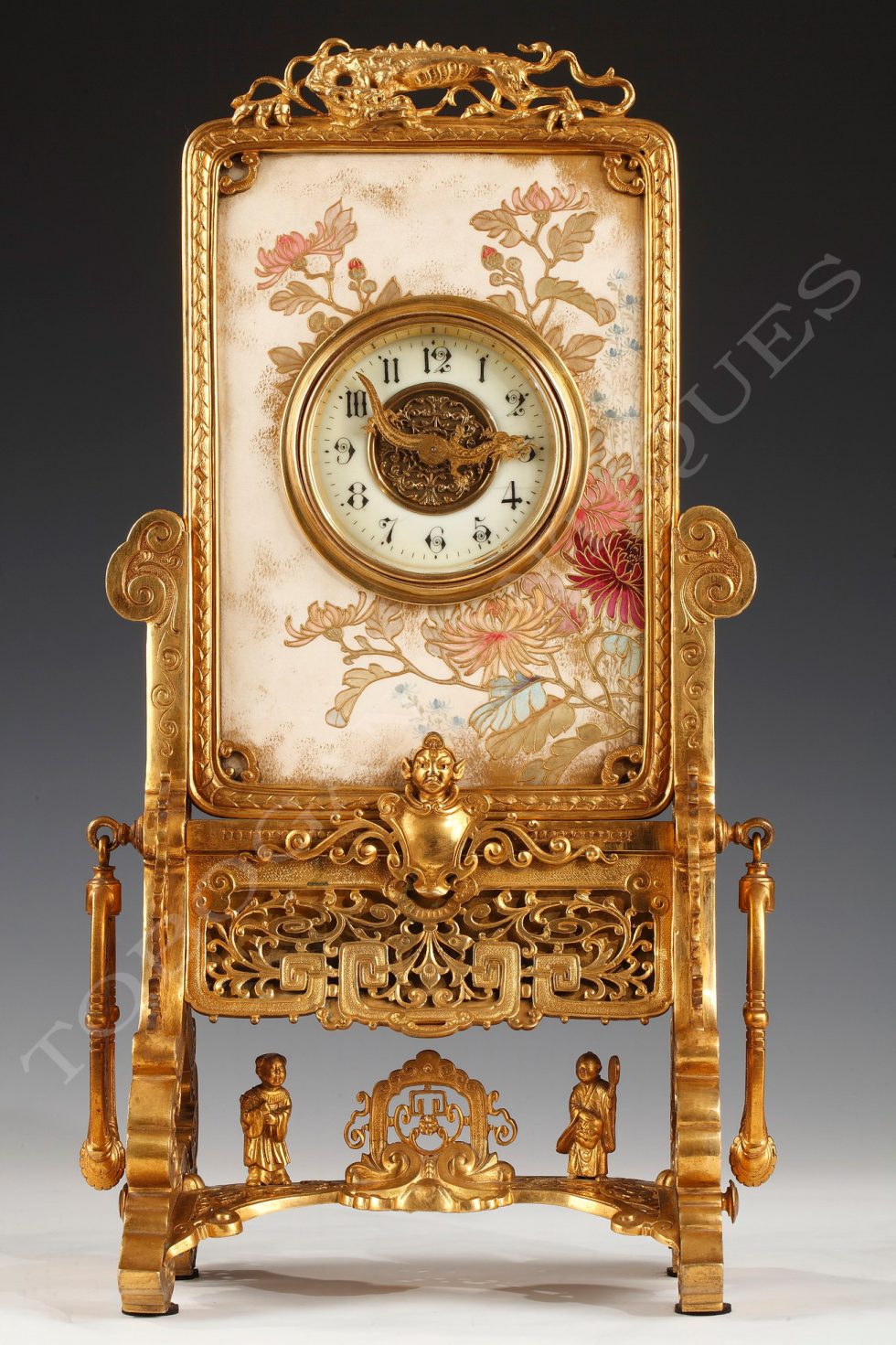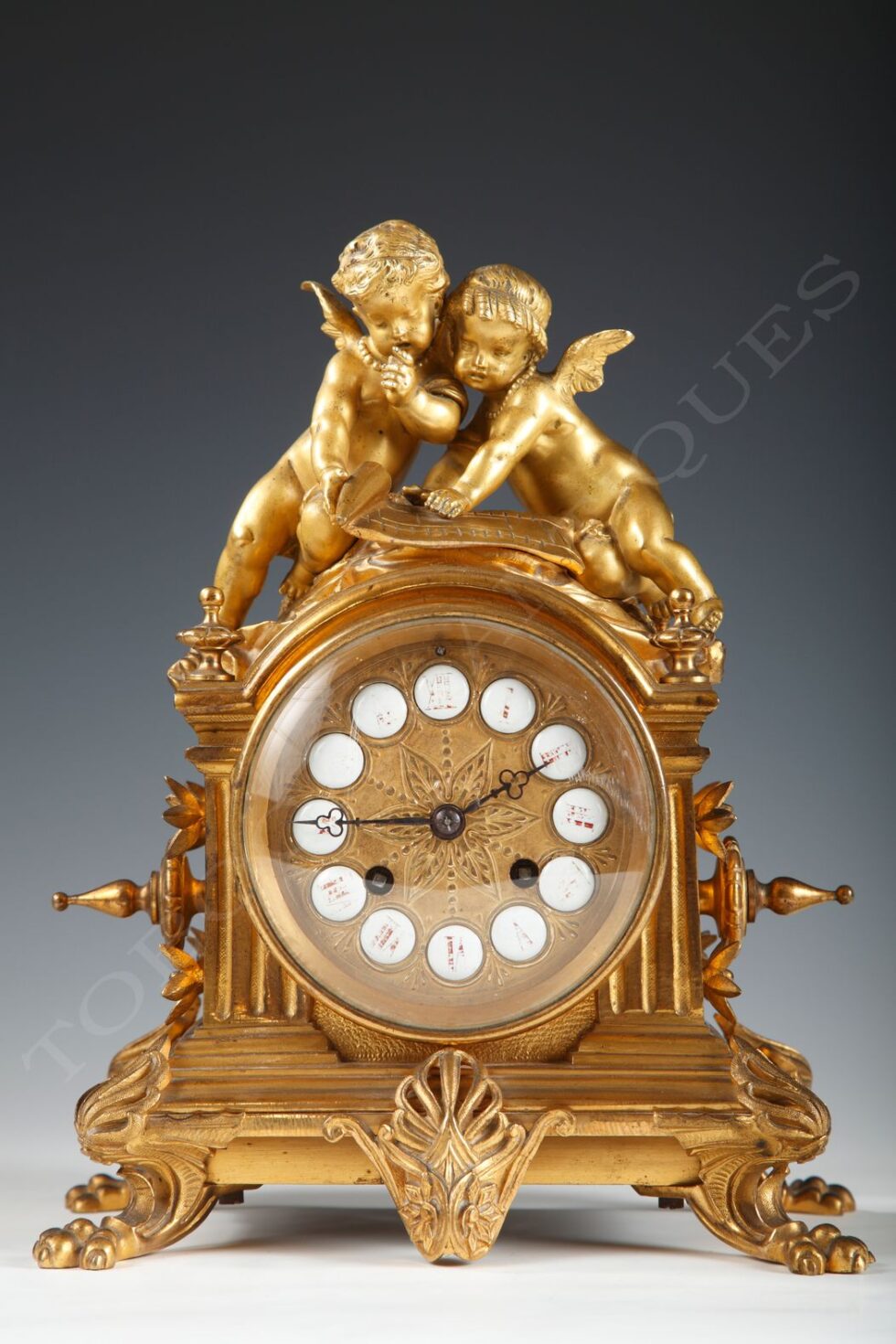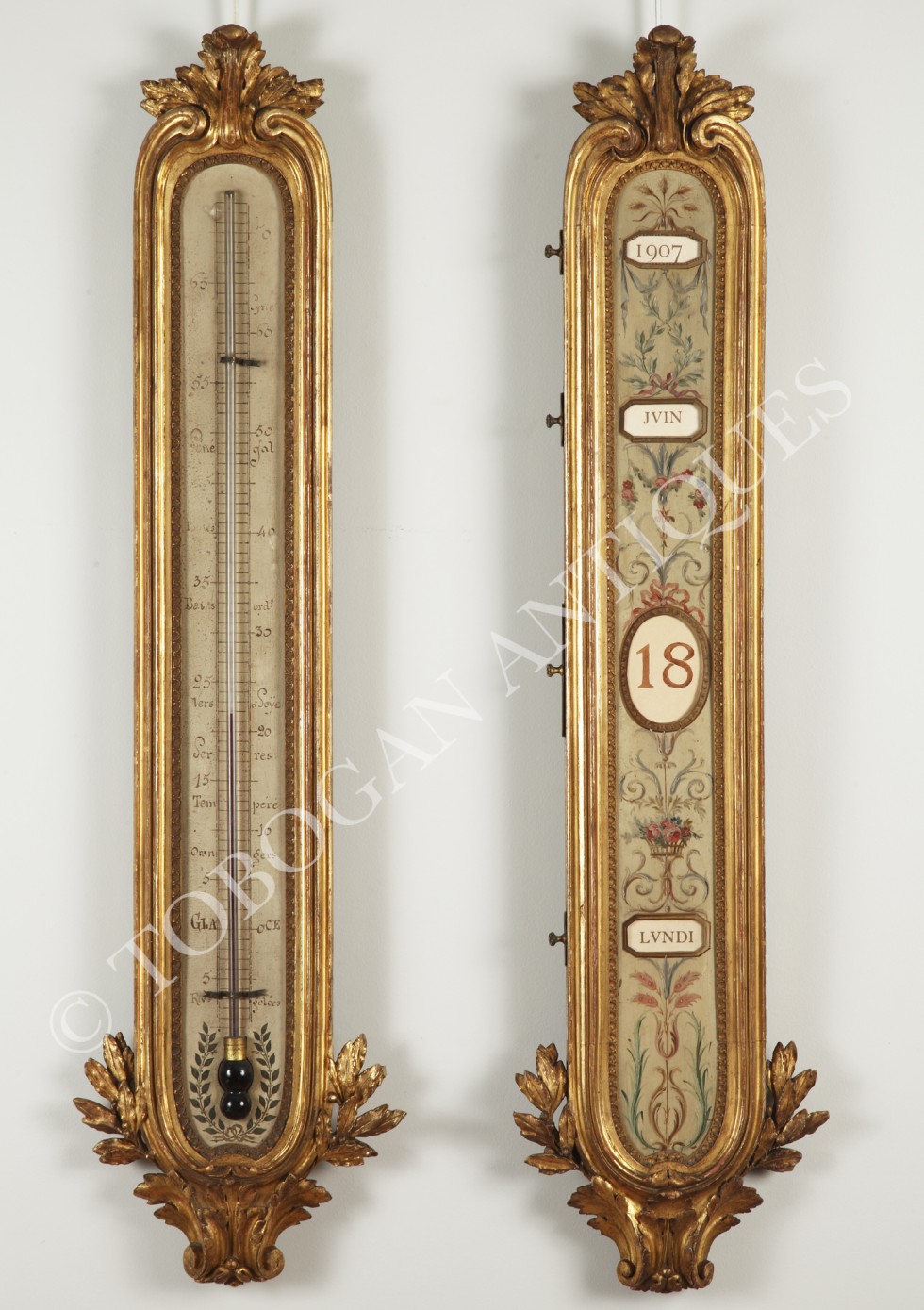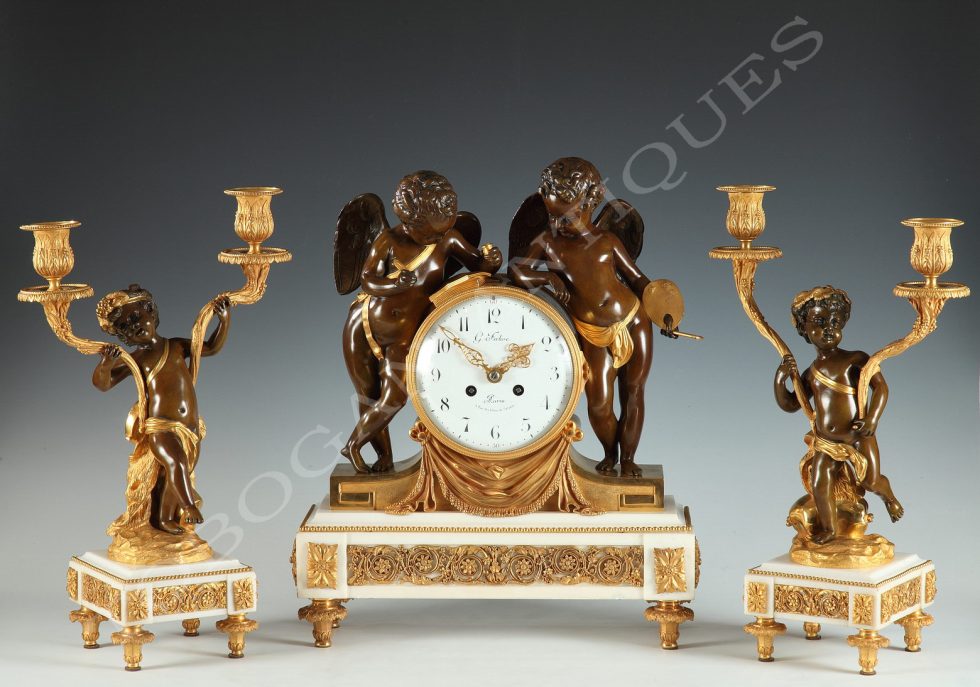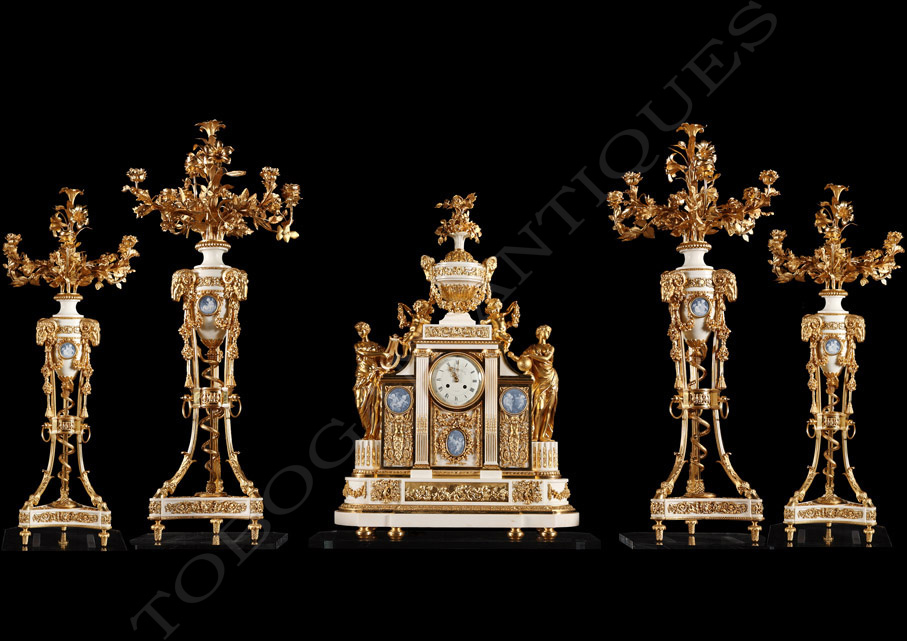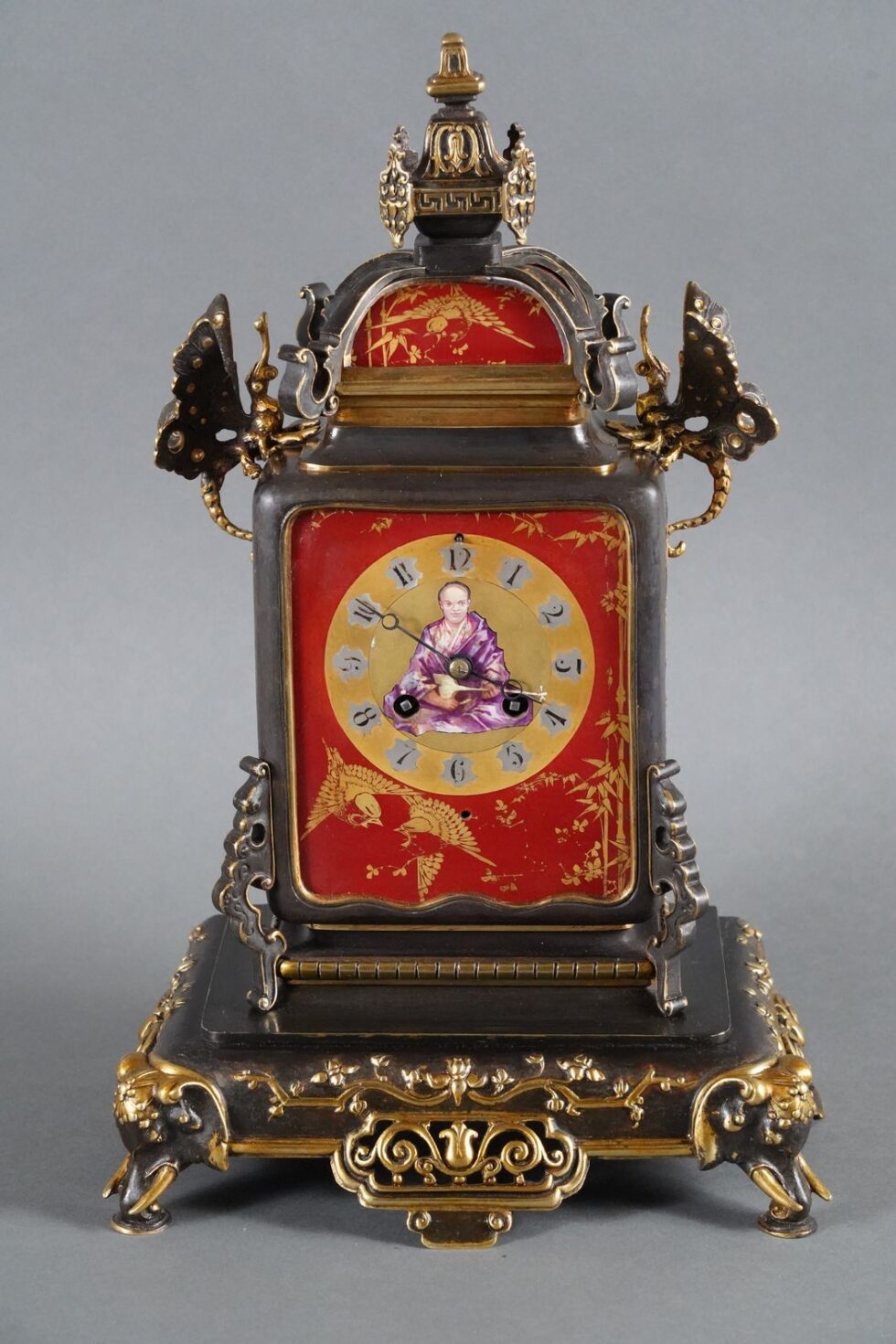ref. 808
A.V. Geoffroy-Dechaume
Sculptor
(1816-1892)
F. Barbedienne
Bronze-caster
(1810-1892)
(attributed to)
Persian mantel clock
France
Circa 1867
Height : 28 cm (11 in.) ; Width : 30 cm (11,8 in.) ; Depth : 12 cm (4,7 in.)
Persian style gilt-bronze mantel clock, with arabesques, leaves and palmets decor, surmonted by a pierced gilt-bronze work. The dial with Roman numerals on white enamel cartouches, is supported by two traditional decorative Khmer beasts. Resting on an onyx base with scrolled feet.
 Our model is very close to a mantel clock designed by the sculptor Geoffroy-Dechaume for the « Maison Delafontaine ». Adolphe-Victor Geoffroy-Dechaume began to work in 1847 for Auguste Maximilien Delafontaine (1813-1892). According to the sculptor’s account books (sketches and pictures reproduced in the exhibit catalog “De plâtre et d’or, Geoffroy-Dechaume, sculpteur romantique de Viollet-le-Duc”, Musée d’art et d’histoire Louis Senlecq, L’Isle-Adam, 1998, p. 88), he provided in 1852 a Persian style clock sketch to the Delafontaine who ask Elmrich to execute it. This clock had been exhibited at the 1855 Paris Universal Exhibition, where Ferdinand Barbedienne could have admired it.
Our model is very close to a mantel clock designed by the sculptor Geoffroy-Dechaume for the « Maison Delafontaine ». Adolphe-Victor Geoffroy-Dechaume began to work in 1847 for Auguste Maximilien Delafontaine (1813-1892). According to the sculptor’s account books (sketches and pictures reproduced in the exhibit catalog “De plâtre et d’or, Geoffroy-Dechaume, sculpteur romantique de Viollet-le-Duc”, Musée d’art et d’histoire Louis Senlecq, L’Isle-Adam, 1998, p. 88), he provided in 1852 a Persian style clock sketch to the Delafontaine who ask Elmrich to execute it. This clock had been exhibited at the 1855 Paris Universal Exhibition, where Ferdinand Barbedienne could have admired it.
This model belongs to the Persian style production of Barbedienne, executed by Geoffroy-Dechaume. This style began with the 1867 Paris Universal Exhibition, where Barbedienne exhibited works inspired by far and middle eastern styles. Among Chinese and Japanese style pieces, Persian style pieces were showed: « exceptional jardinieres of several styles, Persian styles models are a real success that will quickly supersede the Chinese and Japanese styles items ». Ferdinand Barbedienne had focused on Indian and Persian style pieces« that you can find among boxes, cups and other charming items covered with palmettes, like Kashmir fabrics. In the same inspiration, two lapis and turquoise blue background lamps decorated with gilt arabesques, a decoration motif as luxurious as it is simple » Barbedienne kept Chinese and Japanese styles for vases and enameled metal boxes, which had a real success.
Biography
Adolphe-Victor Geoffroy-Dechaume (1816-1892), French sculptor and silversmith, studies at the drawing free-program school before joining, in 1831, the Paris «Ecole des Beaux-Arts». He will be David d’Angers’ and James Pradier’ pupil.
Born in 1810, Ferdinand Barbedienne, the most important caster of bronze pieces of art during the second half of the 19th Century, created and directed in Paris one of the principle artistic foundries of his time. Barbedienne specialized in classical reproductions, whose models were exposed in famous European museums. His company’s illustrated catalogues included diverse objects such as busts and ornamental sculpture (clocks, candelabras, cups), sometimes life-sized, and also bronzes for furniture. Apart from his own production, Barbedienne worked for the most renowned sculptors such as Barrias, Clésinger and Carrier-Belleuse. All his works were highly esteemed and he was very appreciated by contemporary critics. At the 1851 London exhibition, Barbedienne’s firm won two « Council medals ». At the 1855 Universal Exhibition, he won a medal of honor. The success of Barbedienne’s firm brought him many official commissions. At the 1862 London Universal Exhibition, Barbedienne won medals in three different categories: Furniture, Silversmith work and Artistic bronzes. Barbedienne was made an officer of the Légion d’Honneur in 1867 and Commander in 1878. He was then designated as «a prince of industry and the king of bronze casting». His glory did not decline with time: at the 1889 Universal Exhibition, the critics thanked Barbedienne for the example he set for other bronze-casters by the perfection of his bronzes
Bibliography
Rapport des délégués ciseleurs, tourneurs et monteurs, lu en séance publique le 8 novembre 1868, «orfèvrerie, bronze, imitation, cuivrerie», Paris, imprimerie Dufour et cie, 1869, p.52.
Alfred Darcel, « L’émaillerie moderne », Gazette des Beaux-arts, t.XXIV, Janvier-juin 1868, p.76.
Anne Dion-Tenenbaum, « Geoffroy-Dechaume et l’orfèvrerie », De plâtre et d’or, Geoffroy-Dechaume, sculpteur romantique de Viollet-le-Duc, catalogue de l’exposition, Musée d’art et d’histoire Louis Senlecq, L’Isle-Adam, 1998, p. 82.
Contact us
Tobogan Newsletter
If you want to be up-to-date with our new acquirings you can sign up to our newsletter.


